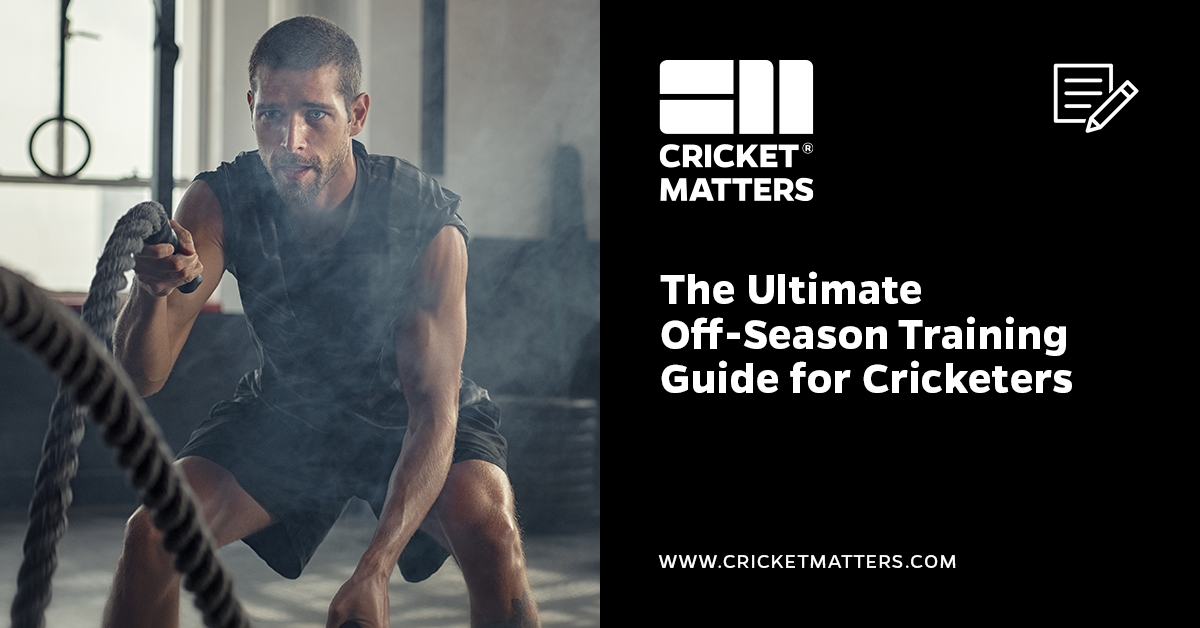
I hope you enjoy reading this blog post.
James Breese, Cricket Matters FounderIf you need my help with cricket coaching, strength and conditioning, injury rehab, or nutrition, click here.
The off-season isn’t just a break from cricket—it’s your chance to get ahead.
While others are resting, this is the time to recover from injuries, build serious strength, and fine-tune your game.
Imagine returning to the field stronger, faster, and more powerful.
Whether you’re a batsman looking for more power or a bowler trying to bowl faster, mastering your off-season training could be the game-changer you need.
In this ultimate guide, we’ll show you how to transform your off-season into a period of growth and preparation, setting the foundation for your best season yet.
Table of Contents
The Critical Role of Off-Season Training in Cricket

The off-season is often seen as a time to relax, but for serious cricketers, it’s one of the most critical periods of the year.
During this time, you can make the greatest strides in your physical conditioning, heal from the season’s toll, and set the foundation to perform at your best next season.
Off-season training goes far beyond the gym; it encompasses mental preparation, injury recovery, and strategic nutrition to ensure you come back stronger, leaner, and more resilient.
Let’s explore the key benefits of this crucial period and how you can maximize it.

Have You Downloaded Our FREE 7-Day Gym Workout Plan?
Grab your complete step-by-step 7-day gym workout plan for cricketers today. There will be no more Guesswork. Just follow the plan and get results.
How Can You Maximise the Benefits of Off-Season Training?

1. Physical Conditioning: Improve Strength, Endurance, and Overall Fitness
The off-season offers an extended window to focus on building your physical capacity without the pressure of weekly matches.
This is the perfect time to work on areas that might have been neglected during the season.
A well-structured program can help you:
- Build Strength: Incorporating weight training focused on compound lifts like squats and deadlifts will give you the power needed for explosive batting, bowling, and fielding.
- Increase Endurance: Working on aerobic capacity ensures you can endure long match days without fatigue. At the same time, anaerobic drills build the quick-burst energy needed for sprints between wickets or chasing down balls in the outfield.
- Enhance Agility: Drills that improve footwork and reaction time can sharpen your movements in the field, allowing you to quickly change direction, dive, and catch balls with more precision.
By dedicating time to structured, progressive training, you’ll return to the field stronger, faster, and more agile than before.
2. Injury Recovery: Heal from Previous Injuries and Prevent Future Ones

The physical demands of cricket often lead to nagging injuries—whether it’s a sore shoulder from repetitive bowling or strained muscles from hours on the field.
The off-season provides a rare chance to recover without the pressure to perform.
- Focus on Recovery: Begin your off-season by allowing the body to heal. Rest is crucial, but active recovery techniques like swimming, foam rolling, or yoga can accelerate healing.
- Injury Prevention: Once you’ve addressed any current injuries, focus on prevention by strengthening key areas. For cricketers, this often means paying extra attention to the shoulders, core, and lower body. By working on mobility and stability, you can significantly reduce the risk of re-injury in the next season.
Incorporating professional support, such as physiotherapy or biomechanical analysis, can be especially valuable at this stage.
It ensures that you recover and correct any imbalances that might have contributed to the injury.
3. Fat Loss and Nutrition: Use This Period to Shed Excess Weight Gained During the Season

The season can be physically demanding and nutritionally imbalanced for many cricketers, especially those who may not have the chance to focus on optimal diet and weight management. The off-season is the ideal time to reassess your diet and body composition.
- Shedding Excess Weight: If you’ve gained unwanted weight during the season, the off-season provides the time and space to focus on fat loss. Create a plan that puts you in a slight caloric deficit, ensuring you lose fat while maintaining muscle mass.
- Nutritional Reset: Focus on nutrient-dense, whole foods that support your recovery and performance goals. Lean proteins, complex carbohydrates, and healthy fats will help rebuild muscle and optimize energy levels for training. This is also the time to hone in on hydration, ensuring you’re consistently well-hydrated for better recovery and performance.
With no immediate matches or travel demands, this period allows you to follow a structured nutrition plan to improve body composition, which is crucial for boosting performance and longevity in the sport.
4. Mental Preparation: Set Goals and Build Confidence for the Upcoming Season

Physical preparation is only one side of the coin. The off-season also provides an invaluable opportunity to work on your mental game. Confidence, focus, and mental toughness can be built and refined during this time.
- Set Clear Goals: Reflect on the past season before diving into your training. What areas need improvement? Whether refining a specific skill or boosting overall fitness, setting clear, actionable goals will give you a roadmap for success.
- Visualization and Mental Rehearsal: This is the perfect time to rehearse match situations mentally. Visualising success—seeing yourself hit a perfect shot or bowl with precision—helps build confidence and reduce anxiety when you face these situations in real life.
- Build Confidence: Small wins during the off-season—hitting a new personal best in the gym or mastering a technical skill—can compound and leave you feeling more self-assured. That mental edge can be as important as physical strength when the pressure is on during a match.
By combining physical conditioning with goal-setting and mental training, the off-season becomes a time to rebuild your body and sharpen your focus and resilience for the season ahead.
By maximising your physical conditioning, addressing injury recovery, refining your nutrition, and focusing on mental preparation, the off-season becomes an essential period of transformation for cricketers.
This is when the groundwork for future success is laid, allowing you to approach the new season stronger and more prepared.

Have You Downloaded Our FREE 7-Day Gym Workout Plan?
Grab your complete step-by-step 7-day gym workout plan for cricketers today. There will be no more Guesswork. Just follow the plan and get results.
Phase 1 – Recovery, Mobility, and Injury Prevention

The first phase of any effective off-season cricket training programme should be focused on recovery, mobility, and injury prevention.
This phase ensures players give their bodies the rest they need after a long season while addressing any lingering injuries and improving overall movement.
Without proper recovery, cricketers risk burnout, overuse injuries, and diminishing performance over time.
Let’s explore how to structure this critical phase.
How Should You Prioritise Rest and Healing?

Cricketers often underestimate the importance of rest, but without it, the body cannot fully recover from the season’s stresses.
Rest isn’t just about physical healing—it’s also essential for mental rejuvenation.
A well-rested body and mind set the stage for effective training in the later phases of the off-season.
Initial Recovery Period:
- The first 1-2 weeks of the off-season should be dedicated to light activity or complete rest, depending on how physically taxing the season was. Use this time to unwind physically and mentally, allowing your body to reset.
- Example: Instead of jumping straight into training, focus on walking, swimming, or low-impact activities during this period to stay active without overburdening your system.
Injury Assessment:
- After rest, it is vital to assess any injuries or nagging pains from the season. Consulting healthcare professionals such as physiotherapists or sports doctors can help address any underlying issues that may have gone unnoticed. This proactive approach ensures injuries are treated before progressing with intense training.
- Example: A proper injury assessment can prevent minor issues from escalating into something more serious, ensuring you can train effectively and without pain.
Biomechanical Analysis:
- A biomechanical analysis can identify movement inefficiencies or imbalances during this recovery phase. Cricketers often develop subtle imbalances due to repetitive actions, such as bowling or batting, which can lead to overuse injuries. Correcting these issues early on with targeted exercises or adjustments will help reduce injury risk.
- Example: Biomechanical analysis provides a detailed breakdown of your movement patterns, helping you fine-tune your technique and avoid injury when you return to training.
How Can You Enhance Mobility and Flexibility?

Improving mobility and flexibility during the off-season is critical for cricketers, as it directly impacts your ability to move freely on the field.
In this phase, you’ll prepare your body for the more intense strength and power work in later stages.
Focusing on mobility now will improve your performance and reduce injury risk.
Dynamic Stretching:
- Dynamic stretching—such as leg swings, arm circles, or hip rotations—should be incorporated into your daily routine. These movements help warm up the muscles and improve joint mobility, ensuring you’re ready for more intense training.
- Example: Dynamic stretching before any workout ensures that your muscles are warm and your joints are ready to move through their full range of motion.
Mobility Exercises:
- Focus on mobility exercises that target cricketers’ most vulnerable areas: the shoulders and hips. Both are involved in almost every movement on the field, from bowling to diving. Simple shoulder rotations or hip openers can improve mobility in these critical areas.
- Example: Improving shoulder and hip mobility will reduce the risk of injury and enhance your performance in activities like throwing and running.
Foam Rolling and Myofascial Release:
- Incorporating foam rolling or myofascial release techniques can help reduce muscle tightness and improve overall flexibility. These techniques aid in breaking up adhesions in the muscles and connective tissues, promoting better movement and recovery.
- Example: Foam rolling after training sessions will help reduce muscle stiffness, allowing you to move more freely and recover faster.
What Are the Best Injury Prevention Strategies?

Injury prevention is a long-term investment in your cricket career. While the off-season is a time for recovery, it’s also the perfect opportunity to strengthen areas prone to injury.
By focusing on corrective exercises and building stability, cricketers can safeguard themselves against future injuries when they return to full play.
Corrective Exercises:
- Corrective exercises should target any imbalances or weaknesses in the body. These exercises can vary depending on your needs but typically focus on improving posture, alignment, and movement efficiency. Key areas for cricketers include the shoulders, hips, and lower back.
- Example: A tailored corrective exercise plan can address issues like weak glutes or tight hip flexors, improving your ability to perform cricket-specific movements.
Core Stability Workouts:
- A strong core is essential for maintaining stability during quick, explosive movements such as running between wickets or diving in the field. Exercises like planks, bridges, and anti-rotation drills will enhance overall stability and reduce the strain on other areas, like the lower back.
- Example: Core stability improves athletic performance and protects against common lower back and pelvis injuries.
Rotator Cuff Strengthening:
- Cricketers, particularly bowlers, are prone to injury in the shoulder joint, particularly the rotator cuff muscles. Strengthening these small but crucial muscles with specific exercises, such as external rotations or scapular retractions, will protect against strain and injury.
- Example: By incorporating rotator cuff strengthening exercises, you’ll build resilience in one of the most injury-prone areas for cricketers, ensuring you can bowl confidently.
This recovery-focused phase lays the groundwork for the more demanding stages of your off-season training.
By prioritising rest, mobility, and injury prevention now, you’ll set yourself up for success as you move into strength-building and conditioning phases, ready to train harder and smarter without risking injury.
Phase 2 – Building Strength and Power

As you progress through the off-season, the focus shifts from recovery and mobility to building strength and power.
Strength forms the foundation for power, speed, and agility, which are crucial for cricket performance.
In this phase, cricketers need to target compound movements, progressive overload, and core training to create a solid base of strength.
Once the foundation is built, cricket-specific power exercises will elevate your game, allowing you to bat with more force, bowl faster, and move explosively on the field.
How Can You Establish a Solid Strength Foundation?

Strength is the bedrock of athletic performance, especially in cricket, where movements like batting, bowling, and sprinting require raw power and stability.
To build a solid foundation, cricketers must focus on full-body strength through compound exercises while integrating core work to ensure overall stability and balance.
Compound Movements:
- Compound movements, such as squats, deadlifts, and bench presses, target multiple muscle groups simultaneously, which is ideal for building functional strength. These exercises mirror the physical demands of cricket by developing both upper and lower body strength in tandem. Squats and deadlifts, in particular, are essential for developing the lower body power needed for explosive running and quick reaction times.
- Example: Squats and deadlifts are particularly effective at building leg and hip strength, which translates directly to more powerful running between wickets and greater stability while batting or fielding.
Progressive Overload:
- Progressive overload is a training principle that gradually increases resistance or weight over time. This method ensures that your muscles continue to grow stronger by constantly challenging them. For cricketers, this gradual increase in strength is crucial for developing the power needed in fast-paced match situations without risking injury.
- Example: Start with lighter weights to perfect your form, then gradually increase the weekly load. Whether it’s adding an extra 5kg to your squat or an additional set of deadlifts, progressive overload is key to sustained strength development.
Core Strengthening:
- A strong core is essential for all cricket movements, whether swinging the bat or bowling fast. Core exercises such as planks, bridges, and anti-rotation drills strengthen the muscles that stabilise your torso, helping you generate more power while reducing the risk of injury, particularly in the lower back.
- Example: Incorporate exercises like side planks or Pallof presses to challenge your core and build the stability you need to withstand the rotational forces experienced during bowling and batting.
How Can You Develop Cricket-Specific Power?

Cricket isn’t just about raw strength; it requires explosive power for short, sharp movements.
To develop this power, cricketers should focus on rotational exercises and plyometric training that translate directly into performance on the field.
By building power in your hips, legs, and core, you’ll be able to hit harder, bowl faster, and move quicker.
Rotational Exercises:
- Rotational movements are integral to both batting and bowling. Medicine ball throws, for example, mimic the rotational force required in a batting stroke, helping to build strength in your obliques and core. These exercises increase your power and improve your movements’ efficiency, allowing you to generate more force with less effort.
- Example: Start incorporating medicine ball slams or rotational throws into your routine to simulate the twisting motions in batting and bowling. These exercises help you transfer energy from your legs and core into your arms, generating more power.”
Plyometric Training:
- Plyometric exercises like box jumps or clap push-ups are designed to increase explosive strength. This type of training is beneficial for cricketers looking to improve their acceleration and power output. Whether sprinting between wickets or jumping to catch a ball, plyometrics build the fast-twitch muscle fibres that drive these movements.
- Example: Plyometrics like box jumps improve lower body power and enhance your ability to accelerate quickly, vital for fielding and running between wickets.
Lower Body Focus:
- Strong legs are essential for cricketers, especially fast bowlers and fielders. Lunges, step-ups, and single-leg squats help build unilateral strength and stability in the lower body, ensuring you have the power and endurance to perform at your best throughout long matches.
- Example: Lunges and step-ups are excellent for building functional lower body strength, mimicking the type of unilateral movements cricketers make when running or bowling.”
How Can You Balance Strength with Mobility?

As cricketers build strength, it’s essential to maintain mobility to avoid becoming stiff and reduce the risk of injury.
Balancing strength training with flexibility ensures that your muscles are strong and capable of moving through a full range of motion, which is vital for cricket-specific movements.
Functional Training:
- Functional training focuses on exercises that mimic the movements you make on the field. By incorporating drills that mirror cricket actions—such as lateral lunges or rotational cable pulls—you build strength, which translates to improved performance during matches.
- Example: Exercises like lateral lunges train your body to move like you would when pivoting quickly to field a ball, ensuring that the strength you build is functional and applicable to cricket.”
Flexibility Maintenance:
- While building strength, it’s essential to continue with flexibility exercises to prevent stiffness and maintain a good range of motion. Regular stretching routines, primarily focusing on the shoulders, hips, and hamstrings, help ensure your muscles remain limber and ready to move explosively.
- Example: Incorporating yoga or simple static stretching into your weekly routine can help balance your strength gains with the mobility required to perform at your best in cricket.
Balanced Workouts:
- Balanced training means focusing equally on pushing and pulling movements to prevent muscular imbalances. For example, if you’re doing a lot of pressing exercises like bench presses, balance them with pulling exercises like rows to ensure that both the front and back of your body are equally strong.
- Example: Balancing your workouts improves overall strength and reduces the likelihood of developing postural issues or imbalances that could lead to injury.
By building a solid strength foundation and developing explosive cricket-specific power, you’ll set yourself up for peak performance on the field.
Maintaining flexibility alongside strength ensures you can move fluidly and confidently, knowing your body is strong and agile.
This off-season phase prepares you for the intense cricket demands, giving you the tools to dominate when you return to play.

Have You Downloaded Our FREE 7-Day Gym Workout Plan?
Grab your complete step-by-step 7-day gym workout plan for cricketers today. There will be no more Guesswork. Just follow the plan and get results.
Phase 3 – Enhancing Aerobic and Anaerobic Fitness

In the off-season, the focus shifts towards building a strong aerobic foundation, which serves as the base for the more intense, anaerobic work in pre-season and competitive matches.
By developing a robust aerobic capacity, cricketers can improve their overall endurance, reduce fatigue during long games, and enhance recovery between high-intensity efforts.
Once this aerobic base is established, cricketers can layer on anaerobic work closer to the season to ensure they’re ready for the explosive demands of the game.
Why Is Building an Aerobic Base Essential for Cricketers?

Cricket demands long hours of focus, stamina, and physical effort.
The off-season is the perfect time to build an aerobic base, which helps cricketers sustain energy throughout these long matches.
Aerobic training is often overlooked in favour of high-intensity work. Still, a well-developed aerobic system improves overall performance and allows players to recover more effectively between bouts of anaerobic effort.
Aerobic Fitness:
- Sustained Energy for Long Matches: Aerobic fitness enables cricketers to stay active for more extended periods without fatiguing. A strong aerobic base ensures your body can efficiently use oxygen to fuel prolonged activity, keeping you alert and energetic through long match days. This type of fitness also helps in quicker recovery between overs or spells of bowling.
- Example: A long, steady-state run at 60-70% of your maximum heart rate for 30-60 minutes can help build this base, gradually increasing your capacity to maintain a higher level of play for extended periods.
Anaerobic Fitness (Later Stages):
- Quick Bursts for Sprinting and Explosive Actions: While aerobic fitness should be the primary focus during the off-season, it’s still important to maintain some degree of anaerobic fitness. Anaerobic exercises come into play when cricketers must perform explosive movements, such as sprinting between wickets or diving to stop a boundary. However, these efforts should be built on the foundation of a strong aerobic system, with more intense anaerobic work introduced closer to the pre-season.
- Example: Anaerobic work, such as short sprints or quick burst efforts, can be layered into training as pre-season approaches, but only once a solid aerobic base has been established.
How Can Interval Training Support Aerobic Development?

While high-intensity interval training (HIIT) is commonly associated with anaerobic conditioning, lower-intensity interval training (such as tempo intervals) can be an excellent way to develop aerobic capacity.
By focusing on slightly longer intervals at moderate intensities, cricketers can improve their ability to sustain a higher aerobic workload over time.
Low-Intensity Interval Training (LIIT):
- Combine Moderate Intensity with Rest: For cricketers, off-season interval training should focus on moderate efforts over longer periods. For example, work intervals at 70-80% of your maximum heart rate, followed by equal or slightly longer recovery periods. This type of training helps develop aerobic efficiency without placing excessive strain on the body.
- Example: Perform 4-6 intervals of 3-4 minute runs at a moderate intensity (70-80% max heart rate), with 2-3 minutes of walking or light jogging in between. This builds your aerobic capacity and endurance, crucial for long match days.
Tempo Runs:
- Sustained Moderate Effort: Tempo runs are another excellent method for improving aerobic capacity. These runs should be performed at a comfortably hard pace, allowing you to sustain the effort for 20-40 minutes without becoming overly tired. Tempo runs teach your body to maintain speed and stamina over long periods, benefiting your performance in prolonged cricket matches.
- Example: Run steadily for 20-30 minutes, focusing on maintaining a consistent speed below your maximum aerobic threshold.
Sprint Workouts for Anaerobic Power (Later Stages):
- Short Sprints to Improve Speed Between Wickets: In the latter stages of off-season training or as you move into pre-season, you can reintroduce anaerobic work like sprints. These short, high-intensity efforts help develop the explosive power needed for quick movements during a match.
- Example: Introduce short, sharp sprint intervals of 10-20 metres with full recovery in between during the later off-season or early pre-season. This type of training helps prepare your body for the demands of sprinting between wickets.
How Should Cricketers Condition Themselves Without Overtraining?

Conditioning during the off-season should strike a balance between pushing your limits and avoiding the pitfalls of overtraining.
It’s easy to fall into the trap of doing too much, especially when motivated to progress.
Still, excessive physical stress can lead to fatigue, injury, and diminished performance when the season starts.
To build stamina and strength efficiently, cricketers need specific training and enjoyable, low-impact activities that promote overall fitness without putting undue strain on the body.
Avoid Overtraining Through Active Recovery:
- Incorporate Enjoyable, Low-Impact Activities: Conditioning isn’t always about structured runs or gym sessions. One of the best ways to stay fit and avoid overtraining is to engage in fun, low-impact activities that keep you moving without stressing the body like intense training does. For example, my personal favourite, snowboarding, is an excellent way to build endurance and strength while giving your joints a break from the repetitive impact of running or strength training.
- Example: For me, an experienced snowboarder, a full day of snowboarding provides a great workout for your legs and core, keeps your heart rate up, and helps you build stamina, all while enjoying time outdoors. Plus, it allows you to stay active without the mental and physical burnout from traditional training.
Mix in Sport-Specific Conditioning:
- Simulate Match Scenarios: While it’s essential to avoid overtraining, you also want to stay sharp with sport-specific conditioning. This can include low-intensity runs, fielding drills, or sprints that mimic cricket’s start-stop nature. By working on cricket-relevant movements in a controlled and moderate way, you stay prepared for the season without overloading your system.
- Example: Incorporate sprint drills between wickets or practice catching and fielding drills with moderate intensity. This ensures your body stays conditioned for the demands of cricket without the risk of pushing too hard during the off-season.
Plan Your Recovery Wisely:
- Use Active Rest Days for Recovery: Active recovery is key to preventing overtraining and allowing your body to heal. This doesn’t mean complete rest; it involves low-intensity activities like walking, swimming, or hiking that promote blood flow and muscle recovery without taxing your system. Activities like snowboarding also serve this purpose, giving your body the movement it needs without the strain of high-intensity training.
- Example: Dedicate 1-2 days a week to active recovery, where you focus on light activities. For instance, a day spent hiking or snowboarding offers a break from the gym while keeping your muscles engaged and primed for the next training session.
By incorporating enjoyable activities like snowboarding, cricketers can stay conditioned and avoid the burnout often accompanying intense off-season training.
Mixing in sport-specific drills and allowing for active recovery will ensure you’re fit and ready for the season without risking injury or overtraining.
How Can You Utilise the Off-Season for Fat Loss?

For most athletes, including cricketers, the in-season period is focused on performance, and it’s not the ideal time to focus on fat loss.
Studies have shown that athletes often gain weight and body fat during the competitive season, as the focus is on recovery and maintaining energy levels for matches.
For instance, research on female soccer players has indicated that many athletes gain fat during the season due to increased caloric intake and reduced time for structured training focused on fat loss.
In-season demands make it difficult to sustain a caloric deficit or focus on fat loss without compromising performance, strength, and energy.
However, the off-season provides the perfect opportunity to shift this focus.
By reducing body fat during this period, cricketers can improve key aspects of their performance, such as speed, agility, and endurance, while maintaining muscle mass.
A leaner physique translates to an improved power-to-weight ratio, better movement efficiency, and reduced joint strain, all of which contribute to enhanced performance when the season begins.
This is the time to take control of your nutrition and training, shed unwanted fat, and enter the next season in peak condition.
Caloric Deficit:
- Adjust Calorie Intake for Fat Loss: To lose fat, you must create a caloric deficit, which means consuming fewer calories than your body burns. However, it’s essential to do this gradually to avoid muscle loss. A moderate deficit of around 20% below your maintenance calorie level is often effective for steady, sustainable fat loss while preserving muscle mass.
- Example: By reducing your caloric intake by 300-500 calories daily, you can steadily lose fat while maintaining the energy needed to support your off-season training programme.
Nutrient-Dense Foods:
- Prioritise Whole Foods for Fat Loss: Nutrient-dense, whole foods should be the cornerstone of your fat-loss diet. These foods are rich in fibre, vitamins, and minerals, helping you stay full and satisfied while providing essential nutrients for recovery and performance. Focus on fruits, vegetables, lean proteins, and healthy fats to ensure your diet supports fat loss and overall health.
- Example: Replace processed, calorie-dense snacks with whole food options like lean meats, fish, leafy greens, and whole grains to support fat loss without feeling deprived.
Balanced Macronutrients:
- Ensure Adequate Protein Intake: Protein is critical for maintaining muscle mass while losing fat. Aim to consume around 1.6-2.2 grams of protein per kilogram of body weight daily to support muscle repair and growth. Protein also has a higher thermic effect than carbs or fats, meaning your body burns more calories digesting it.
Example: Include protein-rich foods like chicken, fish, eggs, and plant-based options such as lentils and beans in every meal to ensure you’re meeting your protein needs while promoting fat loss.
How Do Hydration and Recovery Impact Fat Loss?

Hydration and recovery are often overlooked in fat loss strategies but are crucial for cricketers aiming to optimise their off-season nutrition.
Proper hydration supports metabolic function, while adequate sleep and strategic meal timing enhance recovery.
These factors allow your body to function at its best as you lose fat and build strength.
Hydration:
- Maintain Fluid Intake to Support Metabolism: Staying hydrated is essential for fat loss and performance. Water helps regulate body temperature, supports digestion, and aids in nutrient absorption, which is crucial when reducing calories. Dehydration can slow down metabolism, reduce energy levels, and hinder recovery.
- Example: Aim to drink at least 2-3 litres of water daily, adjusting for exercise intensity and climate conditions to ensure you stay hydrated.
Rest and Sleep:
- Prioritise Sleep for Fat Loss and Recovery: Sleep plays a crucial role in fat loss, muscle repair, and overall recovery. Studies have shown that insufficient sleep can negatively impact fat loss by disrupting hormones that regulate hunger and metabolism. Aim for 7-9 hours of quality sleep per night to enhance your body’s ability to recover, manage stress, and efficiently burn fat.
- Example: Establish a consistent sleep routine by going to bed and waking up at the same time each day, and minimise screen time before bed to improve sleep quality.
Meal Timing:
- Optimise Nutrient Intake Around Training: When you eat is just as important as what you eat. Proper meal timing can improve energy levels for training and enhance recovery. For cricketers focusing on fat loss, ensuring you’re fuelling your workouts with the right balance of carbohydrates and protein to maintain energy and promote muscle repair is essential.
- Example: Consume a meal or snack with a good mix of carbs and protein 1-2 hours before training to fuel your workout, and follow up with a protein-rich meal within an hour after training to kickstart recovery and muscle repair.
By focusing on a strategic caloric deficit, prioritising whole foods, and ensuring balanced macronutrient intake, cricketers can use the off-season to shed unwanted fat while preserving muscle.
Hydration, sleep, and meal timing are equally important in supporting fat loss, ensuring your body functions optimally throughout this period.
With the right nutrition strategy, you’ll be primed for performance, ready to hit the next season leaner, stronger, and fitter.
Maximising Your Off-Season Physical Training

The off-season is your chance to lay the groundwork for success in the upcoming cricket season.
While motivation can initially be high, consistency and commitment are the key to maximising your physical training.
This period is a marathon, not a sprint, and staying focused on your long-term goals is essential.
With the right balance of structured training, professional support, and recovery, you can enter the next season stronger and fitter than ever.
How Can You Stay Consistent and Committed to Your Off-Season Training?

Consistency is the most important factor in seeing any off-season training programme results.
Cricketers often start with enthusiasm but lose focus as the off-season progresses. Staying committed means creating a plan, sticking to it, and regularly assessing your progress to ensure you’re on track.
Regular Training Schedule:
- Stick to a Structured Plan: The best way to stay consistent is to have a straightforward, structured training programme in place. This includes strength training, aerobic conditioning, skill work, and recovery periods. A schedule reduces the risk of missing workouts and can better manage your time.
- Example: Create a weekly schedule alternating strength, aerobic, and mobility work, with specific goals for each session. Sticking to this plan will help ensure steady progress over the off-season.
Progress Tracking:
- Monitor Your Progress: Regularly tracking your progress is key to staying motivated and ensuring effective training. Use measurable benchmarks such as strength gains, speed improvements, or changes in body composition to see how far you’ve come and where you need to adjust.
- Example: Keep a training journal or use an app to record lifts, sprint times, or body fat percentage. Seeing tangible improvements will keep you motivated and committed to your training.
Stay Motivated:
- Set Achievable Goals and Celebrate Milestones: Setting short-term and long-term goals gives you something to aim for and keeps your training focused. Breaking bigger goals into smaller, achievable milestones helps you stay motivated. Celebrate each victory—whether hitting a personal best in the gym or reaching a new fitness level.
- Example: Set a goal to increase your squat by 10kg or reduce your 5K run time by 30 seconds over six weeks. Each time you hit a goal, reward yourself to stay engaged.
Why Should Cricketers Seek Professional Guidance During the Off-Season?

The off-season is the perfect time to fine-tune your training and nutrition with the help of professionals.
Working with a strength coach or nutritionist can help you address weak areas, adjust your training programme, and create a nutrition plan that aligns with your goals.
Expert support ensures you’re on the right track and maximises your results. (That’s why we exist at Cricket Matters!)
Consult Experts:
- Work with Trainers for Technique and Adjustments: Trainers can help you refine your technique, preventing injury and ensuring you perform exercises optimally. They can adjust your training programme as needed, ensuring you progress efficiently without overtraining or stagnating.
- Example: A strength and conditioning expert can evaluate your form on key lifts like squats or deadlifts, helping you lift safely while maximising strength gains.
Medical Check-Ups:
- Ensure You’re Fit to Train: A medical check-up is a good idea before starting an intensive off-season programme, especially if you’re recovering from injury or have health concerns. This ensures you’re physically ready for the demands of training.
- Example: Before beginning your training routine, schedule a physical with your doctor or a physiotherapist to assess any lingering injuries or imbalances.
Nutrition Support:
- Seek Personalised Nutrition Advice: A nutritionist can help you develop a meal plan that supports your goals, whether it’s fat loss, muscle gain, or performance optimisation. Personalised advice ensures you eat the right foods in the correct quantities for your specific needs.
- Example: Work with a nutritionist to create a meal plan that aligns with your off-season goals. This will ensure you’re fueling your training while effectively managing body composition.
How Can Cricketers Prevent Burnout and Maintain Mental Well-Being?

Training hard is essential, but so is rest and recovery.
Overtraining can lead to physical fatigue, mental burnout, and injury.
Cricketers need a holistic approach to their off-season, balancing intense training with rest, recovery, and mental well-being.
A balanced lifestyle helps maintain motivation and keeps you in peak condition without risking burnout.
Balance Training and Rest:
- Schedule Regular Rest Days: Recovery is just as important as training. Incorporate rest days into your schedule to allow your body to recover, repair, and grow stronger. Active recovery activities such as walking, swimming, or yoga can help you stay mobile without overloading your system.
- Example: Plan at least one full rest day per week and include active recovery sessions to ensure your body has time to heal and adapt.
Mental Well-Being:
- Keep a Positive Mindset: It’s easy to lose motivation or feel discouraged if you don’t see immediate results. Practice mindfulness, focus on your goals, and keep a positive attitude. Mental toughness is as important as physical strength when sticking to a long-term plan.
- Example: Use techniques like visualisation or meditation to manage stress and stay focused on your goals during the off-season. Visualise yourself succeeding on the field to reinforce a positive mindset.
Lifestyle Adjustments:
- Adopt Healthy Habits: Staying fit isn’t just about what you do in the gym. Lifestyle factors such as sleep, nutrition, and stress management play a role in performance and recovery. Focus on improving these aspects outside of training to maximise your overall well-being.
- Example: Develop a consistent sleep schedule, reduce stress with mindfulness techniques, and ensure you eat nutrient-dense meals during the off-season to support your physical goals.
Cricketers can maximise their off-season training by staying consistent, seeking expert guidance, and taking a holistic approach to recovery and well-being.
Balancing hard work with rest ensures physical and mental readiness for the upcoming season’s challenges, setting the stage for success on the field.
Conclusion: Off-Season Training for Cricketers

The off-season is more than just a break from the game—it’s your opportunity to rebuild, refocus, and come back stronger.
By dedicating time to physical conditioning, strength training, and mental resilience, you can lay the foundation for a successful season ahead.
Whether you’re building a solid aerobic base, refining your strength and power, or using this time for targeted fat loss, every aspect of your training has a purpose.
Cricketers who maximise their off-season by following structured, intentional training and recovery plans will return to the field stronger, more agile, and better prepared to perform at their peak.
Focus on consistency, seek professional guidance when needed, and take a holistic approach to your training, ensuring you balance intense workouts with adequate recovery.
Adopting these strategies will elevate your physical capabilities and sharpen your mental resilience, giving you the edge when the new season begins.
Now is the time to commit, train smart, and take actionable steps toward becoming the best cricketer you can be.
FAQ’s
What Is the Importance of Off-Season Training for Cricketers?
Off-season training is crucial for cricketers because it provides the ideal window to work on areas often neglected during the competitive season. The focus is on maintaining performance during the season, but the off-season allows players to target long-term physical improvements. Building strength, improving aerobic fitness, and working on injury prevention are all possible in this period, without the pressure of match-day performance. Off-season training enhances mental resilience, allowing cricketers to set new goals and improve focus. Ultimately, a well-structured off-season plan helps cricketers return to the field stronger, fitter, and better prepared for the demands of the game.
How Can Cricketers Maximize Fat Loss During the Off-Season?
Cricketers can maximise fat loss during the off-season by focusing on key principles. First, creating a caloric deficit is essential—consuming fewer calories than the body burns. However, it’s important to maintain muscle mass during this period, so a diet rich in protein is crucial. Including nutrient-dense whole foods like vegetables, lean proteins, and healthy fats ensures you’re fuelling the body properly. Regular strength training should accompany the diet to help preserve muscle while shedding fat. Aerobic exercise, such as steady-state cardio or interval training, can enhance fat loss by increasing caloric expenditure. The off-season is the best time to focus on body composition, as players have fewer performance pressures than in-season training.
Why Should Cricketers Focus on Building an Aerobic Base in the Off-Season?
Building a strong aerobic base during the off-season is key for cricketers because it supports endurance and long-term fitness. Cricket is a sport that demands both prolonged periods of low-intensity activity and short bursts of high-intensity action. By developing aerobic fitness in the off-season, cricketers can improve their ability to sustain energy over long match days and recover more effectively between bouts of explosive movement. This fitness base will serve them well during pre-season and in-season when the focus shifts to anaerobic efforts like sprinting. Aerobic training can also aid fat loss and improve overall cardiovascular health, critical for longevity in the sport.
How Can Cricketers Prevent Overtraining While Staying Fit in the Off-Season?
Preventing overtraining ensures that cricketers remain fit and injury-free during the off-season. A well-structured training plan should balance hard work with adequate rest. Incorporating skiing, snowboarding or hiking into the off-season routine can provide great conditioning without the repetitive strain of traditional workouts. Rest days and active recovery in the programme are also important. It might involve low-impact activities like swimming or light stretching to keep the body moving while allowing muscles to recover. Monitoring physical and mental fatigue is crucial—cricketers should adjust their workload if they start feeling overly tired, ensuring they remain fresh and motivated throughout the off-season.
Why Is Recovery Important in Off-Season Cricket Training?
Recovery is vital in off-season cricket training because it allows the body to repair and adapt to the stress of training. While it’s tempting to push hard daily, overworking can lead to burnout and injuries, ultimately hindering progress. Effective recovery strategies, such as getting 7-9 hours of sleep per night, staying hydrated, and incorporating active recovery sessions like yoga or swimming, help reduce muscle soreness and prepare the body for the next workout. Recovery also plays a key role in mental well-being, helping athletes stay motivated and focused on their goals. Performance and progress can plateau without adequate recovery, making recovery a crucial aspect of any off-season training plan.
What Nutrition Strategies Should Cricketers Follow in the Off-Season?
Cricketers should focus on nutrition strategies that support fat loss, muscle maintenance, and performance recovery during the off-season. This starts with creating a balanced diet rich in whole, nutrient-dense foods like vegetables, lean proteins, and healthy fats. Ensuring adequate protein intake is critical for muscle repair and growth, while healthy fats and complex carbohydrates provide sustained energy. Staying hydrated is essential for metabolic processes, recovery, and overall performance. Regarding meal timing, eating before and after workouts is crucial for fuelling training sessions and enhancing recovery. A personalised nutrition plan that supports each athlete’s specific goals—whether fat loss or muscle gain—is a powerful tool for maximising off-season results.


